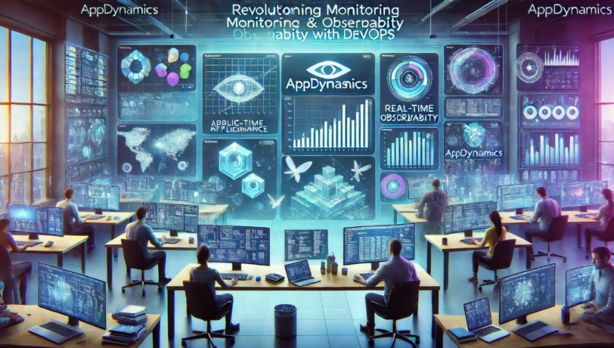Upgrade & Secure Your Future with DevOps, SRE, DevSecOps, MLOps!
We spend hours on Instagram and YouTube and waste money on coffee and fast food, but won’t spend 30 minutes a day learning skills to boost our careers.
Master in DevOps, SRE, DevSecOps & MLOps!
Learn from Guru Rajesh Kumar and double your salary in just one year.

In today’s high-speed digital world, where applications are the backbone of businesses, ensuring seamless performance isn’t just an option—it’s a necessity. With increasing complexities in IT infrastructures and user expectations soaring, tools like AppDynamics have emerged as a game-changer. Combining the power of DevOps principles with cutting-edge monitoring and observability solutions, AppDynamics empowers organizations to stay ahead of performance issues, ensuring smooth user experiences.
What is AppDynamics and Why Does it Matter?
AppDynamics is a leading application performance management (APM) solution that provides visibility into your application stack, from the backend infrastructure to the end-user experience. But what sets it apart? AppDynamics doesn’t just monitor—it helps teams observe, analyze, and act in real-time. When coupled with DevOps practices, AppDynamics ensures applications are not only functioning but thriving.
Imagine a world where every glitch is identified and addressed before it impacts users. This is what AppDynamics, backed by DevOps principles, promises.
The Role of DevOps in Monitoring and Observability
DevOps bridges the gap between development and operations teams, fostering collaboration and efficiency. When applied to monitoring and observability, DevOps transforms the way teams interact with application data, ensuring proactive resolutions instead of reactive firefighting.
Key principles of DevOps in observability include:
- Continuous Monitoring: Always know what’s happening in your applications.
- Automation: Eliminate manual processes that slow down response times.
- Collaboration: Align developers, operations, and even business stakeholders.
- Feedback Loops: Learn and adapt continuously based on real-time data.
AppDynamics uses these principles to create a unified ecosystem where monitoring meets actionable insights.

How AppDynamics Enhances Monitoring with DevOps
1. End-to-End Visibility
AppDynamics provides a holistic view of the application lifecycle. From tracking user clicks to analyzing backend processes, every touchpoint is monitored. This isn’t just about knowing what’s wrong; it’s about seeing how everything connects, making it easier to pinpoint issues.
2. Real-Time Anomaly Detection
With AI and machine learning baked into its core, AppDynamics detects anomalies in real time. For instance:
- If your e-commerce site slows down during a sale, AppDynamics flags it immediately.
- It identifies whether the issue lies in the database, code, or infrastructure.
This ensures faster mean time to resolution (MTTR) and minimal user disruptions.
3. Integration with CI/CD Pipelines
DevOps thrives on Continuous Integration/Continuous Delivery (CI/CD) pipelines. AppDynamics seamlessly integrates into these workflows, allowing teams to monitor how every new code deployment impacts performance. Teams can:
- Roll back problematic updates quickly.
- Optimize application features based on real-time feedback.
4. Unified Metrics Across Teams
For too long, developers, operations, and business teams have worked in silos. AppDynamics unifies these teams by providing shared dashboards:
- Developers see how their code impacts performance.
- Operations identify infrastructure bottlenecks.
- Business teams analyze how technical issues affect revenue.
This shared perspective fosters better collaboration.
Observability: Beyond Traditional Monitoring
While monitoring answers the “what,” observability answers the “why.” AppDynamics excels at providing observability by:
- Combining Metrics, Logs, and Traces (MELT): Every data point contributes to a comprehensive understanding of system health.
- Visualizing Dependencies: See how microservices and APIs interact, making troubleshooting faster and more effective.
- Contextual Insights: Tie application performance to business outcomes, ensuring you prioritize the right issues.
Benefits of Using AppDynamics in DevOps
Here’s how AppDynamics makes a difference:
- Proactive Problem Solving: Address issues before they escalate.
- Enhanced Collaboration: A shared view fosters better teamwork.
- Faster Time-to-Market: Monitor new releases without fear.
- Cost Efficiency: Prevent downtime, saving on incident management costs.
- Improved User Experience: Happy users mean better business.
Real-Life Use Cases
Example 1: Retail Giant’s Black Friday Success
A global retailer used AppDynamics to monitor their online store during Black Friday. Thanks to its real-time insights, they managed to prevent downtime, ensuring millions of dollars in uninterrupted sales.
Example 2: Financial Services on Point
A financial institution integrated AppDynamics into their CI/CD pipeline. They identified performance bottlenecks in seconds, enhancing their online banking platform’s speed and reliability.
How to Get Started with AppDynamics in DevOps
- Instrument Your Applications: Use AppDynamics agents to collect performance data.
- Set Alerts: Configure alerts for anomalies and thresholds.
- Visualize with Dashboards: Create dashboards tailored to your team’s needs.
- Automate Workflows: Integrate AppDynamics with tools like Jenkins or Kubernetes.
- Learn and Adapt: Use insights to refine processes and applications continuously.
Images for Better Understanding
- DevOps and AppDynamics Workflow Visualization (Showcases integration between CI/CD pipelines, monitoring tools, and alert mechanisms.)
- Full-Stack Visibility with AppDynamics (Highlights how every layer, from infrastructure to user experience, is monitored.)